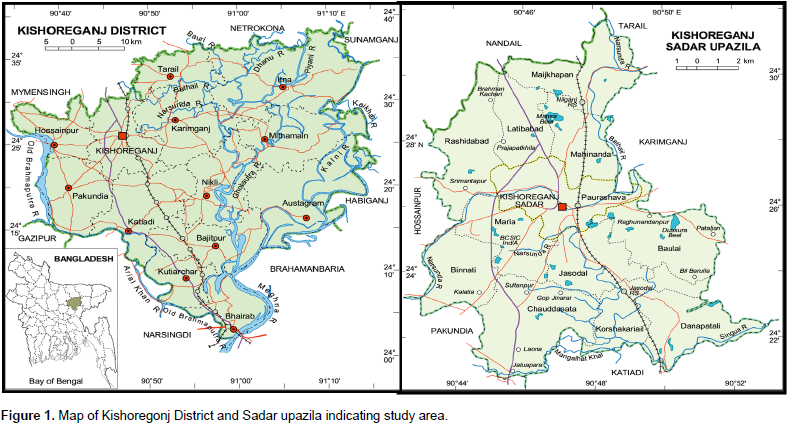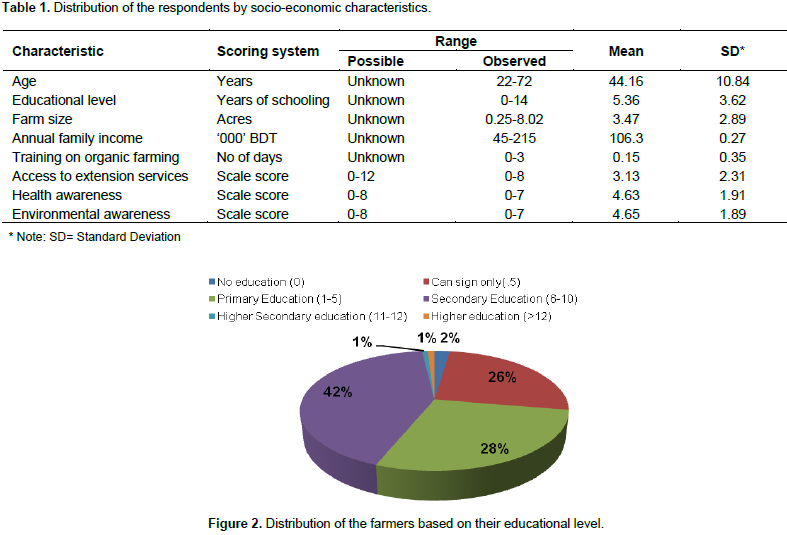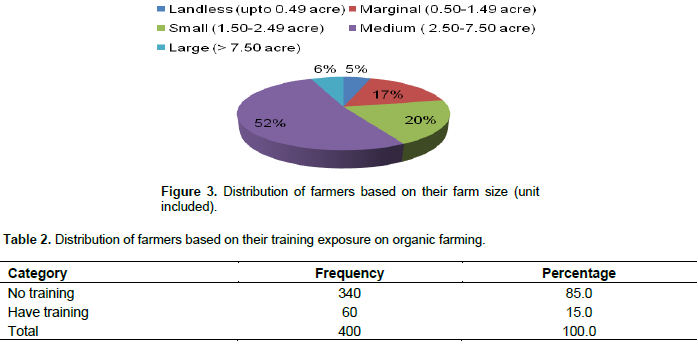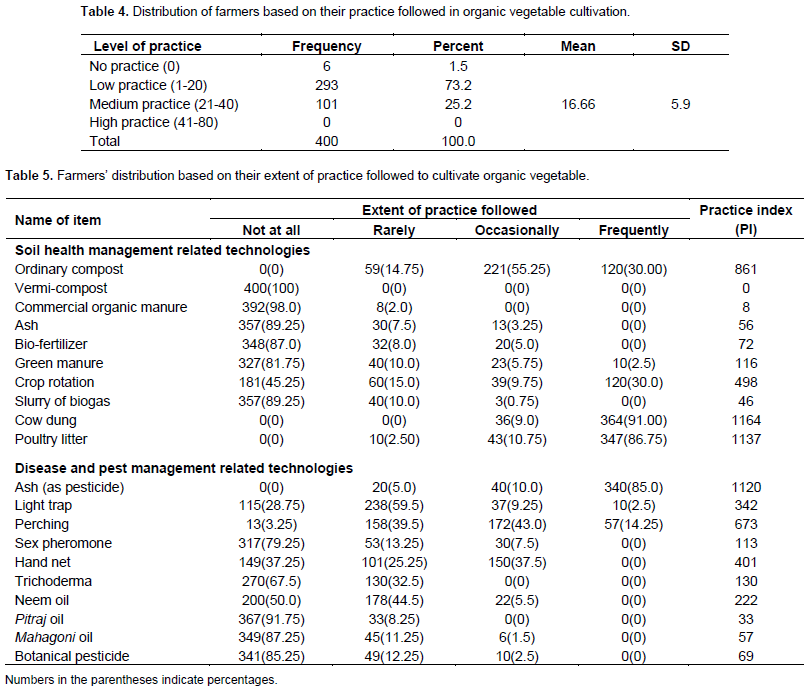ABSTRACT
The study aimed to determine farmers’ knowledge and practice regarding organic vegetable cultivation as well as to ascertain farmers’ awareness concerning health and environmental aspects. The study was conducted at two villages of Kishoregonj District. The selected villages were Shadullar Char and Borobag Char. The total number of household was 800 in two villages. Among them 400 households were randomly selected and the head of each household was considered as the sample of the study; from them data were collected using structured interview schedule. The findings of the study indicate that about two-thirds (65%) of the farmers in the study area had poor knowledge concerning organic vegetable cultivation while, about three-fourth (73%) of the respondents had found low level of practice followed in cultivating organic vegetables. Concerning soil health management aspects, the item namely use of cow dung and use of poultry excreta were the top most items practice by the farmers in their locality. The use of ash and piercing, on the other hand, were found as the highest ranked items regarding disease and pest management related aspects. However, about three-fourths of the respondents had low to medium level of awareness concerning health and environmental related aspects caused by agro-chemicals use.
Key words: Organic vegetable, knowledge, practice, farmers, Bangladesh.
Due to increasing consumer awareness of health and environmental issues, the demand for safe organic food has been growing significantly all over the world for the past several years and this offers producers and exporters in developing countries opportunities to improve their incomes and living conditions (FiBL, 2006). The statistics showed that 2.3 million certified organic farmers are growing organic produces on 43.7 million hectares of land in 172 countries for a global sales of organic food market worth of 80 billion US$ (FiBL and IFOAM, 2016). Among the global organic producing countries, there are 30 countries in Africa, 30 in Asia, 20 in Central America and the Caribbean, 10 in South America, 5 in Australasia and the Pacific and the most countries in Europe, as well as the United States and Canada (IFOAM, 2008). These figures include many developing countries, of which about 15 are regarded as Least Developing Countries (LDCs) (IFOAM, 2008). According to OTA (2012), organic agriculture is the most promising worldwide growth industry which can be profitable and sustainable business for agricultural producers interested in going through the certification process necessary to enter this market. Organic agriculture not only contributes in income improvement, a number of case studies reported that yields have increased substantially after conversion to organic farming (Giovannucci, 2005; Mendoza, 2004; Badgley et al., 2007; Amaduo and Bruno, 2015). Delate et al. (2003) reviewed numerous scientific studies conducted throughout the US between 1985 and 1993, and reported that yields and overall economic returns in organic farming systems demonstrate their economic viability. Organic farming offers an alternative method for production that can be suitably exploited to benefit some segment of farmers (Chand, 2003). Additionally, organic agriculture as one such technology that can reduce the harmful impacts of agro-chemicals, and is considered by many scientists to be the best form of agriculture in terms of maximizing cost-effectiveness and minimizing pollution (Christian et al., 2005).
However, unfortunately Bangladeshi farmers could not get their share from the global organic market and even failed to create a good domestic market of organic produces and developing sustainability of the agricultural systems through adoption of organic agriculture due to lack of proper knowledge on organic cultivation methods. In general, mass farmers in Bangladesh rely on chemical inputs to supply nutrients and manage pests to optimize crop yields. As, Department of Agricultural Extension (DAE) and others public extension organizations do not have any active initiative to disseminate organic agricultural information among the farming community (Rahman and Yamao, 2007). In parallel to these mass farmers, a small group of farmers are practicing organic cultivation methods to lower the production costs, reduce dependency on purchased agro-chemicals, increase income and improve the long-term sustainability of the agricultural system (Sarker and Itohara, 2007). Progress in adopting organic farming has been very slow in many regions of Bangladesh, even though the country has great potential in this regard because of surplus labour, huge crop diversity, and considerable investment by Proshika and few other NGOs since the 1980s (Sarker and Itohara, 2008). Despite having some major problems including the lack of political recognition, Bangladesh has good prospects in organic farming (Sarker and Itohara, 2007). With few exceptions, organic farming in Bangladesh still occurs largely on an experimental basis. Total land area under organic cultivation in Bangladesh has been estimated at 0.177 million hectares (FiBL and IFOAM, 2016), representing only 2% of the country’s total cultivable land. Among the private companies Kazi and Kazi Ltd. is the pioneer to invest in organic farming. They have established organic tea garden at Tetulia, in the Panchagarh district.
This tea is certified by the SGS organic production standard in accordance with the EU Regulation 2092/91, and it is marketed both in local and export market (Tea International, 2005). Sarker and Itohara (2009a,b) reported that following the adoption of organic farming, the average household income declines in the first few years before increasing thereafter and 98% respondent farm households had successfully attained household level food security after adoption of organic farming. In this endeavor, GO’s contribution is really invisible and only few of the NGOs are working to promote organic farming in Bangladesh. This individual approach, however, may result either in the lack of adequate funding or the lack of adequate knowledge of organic farming and/or marketing strategies (Sarker and Itohara, 2007). However, by updating these age-old systems with modern research and technologies it is possible to increase knowledge and practice on organic farming by the Bangladeshi farmers that may open the door of endless possibilities of improving soil health, taking care of environment, and providing sustainable livelihoods for the peoples of the farming community. Thus the present study was taken into consideration with the following objectives:
1. To investigate and explain the socio-economic profile of the organic vegetable farmers;
2. To determine farmers’ knowledge and practice regarding organic vegetable cultivation; and
3. To determine farmers’ awareness concerning health and environmental aspects.
Methodological issue is one of the prime considerations for conducting a research for yielding valid and reliable findings. In fact, it is the foundation on which the research process rests upon. From this point of view the researcher took a great care in using appropriate method. However, the methods and operational procedure, and operation of variables, use of statistical tests- all are presented in this section of the manuscript.
Locale of the study
The study was conducted at two villages of Shadullar Char under Kishoregonj District of Bangladesh. Names of the selected two villages were Shadullar Char and Borobag Char. These two villages were under the Kishoregonj Sadar sub-district under Kishoregonj district (Figure 1). Kishoregonj Sadar is one of the important vegetable growing areas of the district and especially these two selected villages are very famous for diversified vegetable cultivation due to their fertile alluvial soil and close vicinity with district town that has given the vegetable growers better opportunity for marketing their produces. Thus, these two villages were selected purposively for the present study. All of the farm households having involvement with vegetable cultivation in Shadullar Char and Borobag villages were considered as the population of the study. The total number of farm household was 800 in those two villages. Among them 50%, that is 400 households were randomly selected and the head of the household was considered as the sample of the study. A draft interview schedule was prepared for collecting data from the respondent farmers. The schedule was pre-tested in actual field situation. Based on the experiences of pre-testing of the interview schedule, it was modified and amended. The interview schedule was then finalized for the collection of data. The empirical data for the study were collected through pre-tested structured interview schedule from the farmers of the selected villages during 01 April to 05 May 2015. Data were collected by the Field Staff of the Bondhon (A local NGO in the study area), Kishoregonj under the closed monitoring and supervision of the principal investigator and co-investigator of the project.

Variables of the study
Eight individual characteristics of the farmers were considered for the study. The selected characteristics were age, educational level, farm size, annual family income, training exposure, extension media contact, environmental awareness and health awareness. Farmers’ knowledge on organic vegetable cultivation was one of the focus variables and was measured on the basis of the responses of the vegetable farmers to the questions asked them. A total of twelve knowledge related questions were asked and the score could range from 0 to 24. Another focus variable of the study was extent of practices concerning organic vegetable cultivation were divided into two aspects namely soil health management related issues and disease and pest management related issues. A total of twenty (20) practices, that is ten practices from each of the aspect were incorporated into the interview schedule. Farmers’ response for each practice was measures by using a four-point rating scale. So the score could range from 0 to 80. For having better understanding of each of the practices, practice index was developed by using following formula:
PI (Practice Index) = (Pf×3) + (P0×2) + (Pr×1) + (Pn×0)
Where, Pf = Number of respondents with frequent management practices; P0 = Number of respondents with occasional management practices; Pr = Number of respondents with rare management practices; Pn = Number of respondents with not at all management practices. The practice index (PI) of each practice could range from 0 to 1200, where 0 indicates no practice and 1200 indicate frequent practices. Both the qualitative and quantitative data were collected. Quantitative data were collected through direct interviewing with farmers through interview schedules while the qualitative data were collected through Focus Group Discussions (FGDs). The collected data were coded, compiled, tabulated and analyzed as per objectives of the study.
Socio-economic characteristics of the farmers
The empirical data concerning socio-economic characteristics of the respondents were collected and presented in Table 1. Table 1 show that the age of the respondents was ranged from 22 to 72. The mean age of the respondents was 44.16 when standard deviation was 10.84. Education of farmers varied found to vary from 0 to 14 years, the average being 5.36 with a standard deviation 3.62. Based on their age score the respondents were classified into six categories: ‘No Education (0)’, ‘Can sign only (0.5)’, ‘Primary Education (1-5)’, ‘Secondary Education (6-10)’, ‘Higher Secondary Education (11-12)’ and ‘Higher Education (>12)’. Data furnished in the Figure 2 reveal that the highest proportion (42.2%) of the respondents had secondary education. The lowest proportion (0.8%) of the respondents had higher secondary education level. 28.20% of the respondents had primary education and25.50% had can sign only. About 2.20% of the respondents had no education where only 1.0% of the respondents had higher education. However, the average farm size of the respondents was 3.47 acre with a standard deviation of 2.89. Based on their farm size the respondents were classified into five categories: ‘Landless (0.00.49 acre)’, ‘Marginal (5-1.49 acre)’, ‘Small (1.50-2.49 acre)’, ‘Medium (2.50-7.49 acre)’and ‘Large (>7.50 acre)’.

Data presented in the Figure 3 indicated that more than half (52%) of the respondents had medium farm size and only 6% had large farm size. However, 20% of the respondents had small farm size and 17% of the respondents had marginal farm size and only 4.5% of the respondents were land less. Thus, it is clear from the study that medium to large farmers are more interested towards organic vegetable cultivations compared to small and marginal farmers. This is also reality that small and marginal farmers usually do not dare to take risk with organic farming due to their limited farm size. The average annual income of the respondents was 106.69 thousand BDT (Bangladeshi currency; 1US$=approx. 80 BDT) with a standard deviation 0.27. The findings of the study also revealed that mean training received on organic vegetable farming was 0.15 day where standard deviation was 0.35. The study also explored that the highest proportion of the respondents (85.0%) had no training and only 15% of the respondents had received training on organic vegetable cultivation (Table 2). It is really very frustrating that the majority of the farmers do not have any training on organic vegetable cultivation. This is due to the fact that the public extension services do not have proper attention on organic farming. The respondents additionally mentioned that among the recipients of the organic training course, 60% of the respondents received training on compost preparation and 10% received training on integrated pest management (IPM) in vegetable cultivation.

The average score of access to extension services of the respondents was 3.13 with a standard deviation of 2.31. Based on their access to extension services the respondents were classified into four categories: ‘No access (0)’, ‘Low access (1-3)’, ‘Medium access (4-6)’ and ‘High access (>6)’. Data presented in the Figure 4 indicated that the less than half (40.20%) of the respondents had low level access to extension service, while 32.38% had medium access to extension services to get information on organic vegetable cultivation. However, a significant portion (16.80%) of the farmers had no access to extension services and only 10.20% of the respondents had high level access to extension services for organic farming information. The respondents also mentioned that among the majority of them (70%) get necessary information on organic vegetable cultivation from NGO staff and neighboring farmers. While only 2% of the farmers get information from public sector extension staff. However, this finding was supported by the findings of Sarker and Itohara (2008a). The findings of the study also exhibit that the average health awareness score of the respondents ranged from 0-7 with an average score of 4.63 and standard deviation of 1.91. On the other hand, the environmental awareness score of the respondents were ranged from 0 to 7 with an average score of 4.65 and standard deviation of 1.89. It is clear from the study that the environmental and health awareness score of the respondent vegetable farmers was moderate.

Farmers’ knowledge on organic vegetable cultivation
One of the important objectives of the study was to determine farmers’ knowledge on organic vegetable cultivation and data were presented in Table 3. The average knowledge about organic vegetable cultivation of the respondents was 11.70 with a standard deviation 4.69. Based on their knowledge about organic vegetable cultivation, the respondents were classified into three categories: ‘Poor knowledge (1-12)’, ‘Medium knowledge (13-24)’ and ‘High knowledge (25-36)’.Data presented in the Table 3 indicated that the highest proportion (65%) of the respondents had poor knowledge, where 34.50% had medium knowledge and only 0.50% of the respondents had poor knowledge on organic vegetable cultivation.

Farmers’ extent of practice of organic vegetable cultivation
The information regarding extent of practice of organic technologies by the respondents were collected and presented in Table 4. Data presented in Table 4 shows that the average score of farmers’ extent of practice of organic technologies was 16.66 with a standard deviation of 5.90. Based on their practice of organic technology the respondents were classified into four categories: ‘No practice (0)’, ‘low practice (1-20)’, ‘medium practice (21-40)’ and ‘high practice (41-80)’. The study revealed that the around two-thirds (73.20%) of the respondents had low practice, where a quarter (25.20%) had medium practice. However, it is observed that still a small portion (1.5%) of the organic vegetable growing farmers did not practice organic technologies.Moreover, rank order of the organic technologies was made based on the score of the Practice Index (PI) as responded by the farmers (Table 5). Table 5 shows that among the soil health management related technologies, the highest majority (91%) frequently use cow dung after that 87% frequently use poultry litter for soil health management. However, this is really wondering that while vermin-compost is getting popularity in all over the country but none of them are using vermin-compost in soil health management. On the contrary, more than a quarter (30%) of the farmers frequently follows crop rotation practices for maintaining their soil health. While the extent of use of bio-gas slurry, green manure and ordinary compost is still poorer by the farmers of the study area. Like, soil health management the respondents were asked to mention their extent of use of organic technologies relating to disease and pest management in vegetable cultivation.

The findings of the study showed that the highest majority (85%) of the farmers frequently use ash for controlling insect. Next to ash, 14% of the farmers practice perching as a means of biological control for disease and insect pest management. The findings of the study also revealed that few farmers have already started to use sex pheromone, neem oil and other botanicals for managing disease and insect pests. The respondents were asked to indicate the extent of practice followed by the farmers’ in organic vegetable cultivation in a four point rating scale. Frequently, occasionally, rarely and not at all with the weightage of 3, 2, 1 and 0 respectively based on which a Practice Index (PI) was made. Based on PI score different technologies were ranked in an order. From Figure 5, it was evident that farmers’ extent of practice in organic vegetable cultivation, among the soil health management related technologies cow dung was top in the rank order with the Practice Index (PI) of 1164 and it was followed by poultry litter (PI=1137), Simple compost (PI= 861), crop rotation (PI=498), green manure (PI=116), bio-fertilizer (PI=72), ash (PI= 56), slurry of biogas (PI= 46), commercial organic manure (PI=8) and vermi-compost (PI=0). On the other hand, farmers’ extent of practice of disease and pest management technologies in organic vegetable cultivation were also assessed and the findings show that among the selected 10 technologies ash was ranked first with the PI score of 1120 and followed by perching (PI= 673). Next to these two technologies, the use of hand net, light trap, neem oil, sex pheromone, Trichoderma, botanical pesticide, Mehagoni oil and Pitraj oil ranked 3rd, 4th, 5th, 6th, 7th, 8th, 9th and 10th respectively. Thus, it can be concluded that the extent of practice of organic practices in vegetable cultivation in the study area was still low.

CONCLUSION AND RECOMMENDATIONS
Despite the great potentials of organic vegetable cultivation in improving soil, environmental and human health as well as improving farmers’ income, the adoption of Bangladeshi farmers seems to be slow. The major factor behind this reality is poor knowledge of the farmers on organic cultivation. It is evident from the study that about two-thirds (65%) of the farmers in the study area had poor knowledge on organic vegetable cultivation while, a little less than three-fourths (73%) of the respondents had found with low extent of practice of organic technologies in vegetables cultivations. It may be concluded in such a way that there is ample scope to work on the farming communities in the study area about organic vegetable cultivation. Concerning soil health management aspects, the item namely use of cow dung and use of poultry litter were the top most technologies practiced by the farmers in their locality. Use of ash and perching, on the other hand, were found as the highest ranked practices among the disease and pest management related technologies used in vegetable cultivation. However, about three-fourths of the respondents had low to medium level of awareness concerning health and environmental related issues due to use of agrochemicals.
Based on the findings the following recommendations may be put forward:
1. Arrangement of campaigns by the public extension organization (Department of Agricultural Extension) and the local level NGOs need to be increased for improving farmers’ knowledge concerning organic vegetable cultivation.
2. Organization of training programmes as well as conduction of result demonstration by the concerned agencies will be effective in changing the mindset of the farmers regarding organic vegetable cultivation.
3. Conduction of method demonstrations to show the easy way of preparing compost and botanical pesticide might improve the capacity of the farmers in practicing organic technologies.
4. Extension campaign is needed to generate awareness among the farmers concerning health and environmental benefits of organic cultivation methods
The authors have not declared any conflict of interests.
REFERENCES
|
Amaduo BBA, Bruno B (2015). Economic and Environmental Performance of Organic Farming System Compared to Conventional Farming System: A case study of the Horticulture sectorin the Niayes region of Senegal. Procedia Environ. Sci. 29:17-19.
Crossref
|
|
|
|
Badgley C, Moghtader J, Quintero E, Zakem E, Chappell MJ, Avil,s-V zquez K, Samulon A, Perfecto I (2007). Organic Agriculture and the Global Food Supply. Renew. Agric. Food Syst. 22(2):86-108.
Crossref
|
|
|
|
|
Chand R (2003). Government Intervention in Food Grain Markets in the Changing Context, Policy paper No.19, National Centre for Agricultural Economics and Policy Research, New Delhi.
|
|
|
|
|
Christian RV, Kilcher L, Schmidt H (2005). 'Are Standars and Regulations of Organic Framing Moving Away from Small Farmers' Knowledge'? J. Sustain. Agric. 26 (1):5-26.
Crossref
|
|
|
|
|
Delate K, Duffy M, Chase C, Holste A, Friedrich D (2003). An Economic Comparison of Organic and Conventional Grain Crops in a Long-term Agro-ecological Research (LTAR) site in Iowa. Am. J. Altern. Agric. 18(2):59-69.
Crossref
|
|
|
|
|
FiBL and IFOAM (2016). The World of Organic Agriculture: Statistics & Emerging Trends 2016.
|
|
|
|
|
FiBL (2006). The World of Organic Agriculture, Statistics and Emerging Trends 2005.
|
|
|
|
|
Giovannucci D (2005). Organic Agriculture and Poverty Reduction in Asia: China and India Focus. Thematic Evaluation, International Fund for Agricultural Development (IFAD), Rome, Italy.
|
|
|
|
|
IFOAM (2008). Statistics of the World of Organic Agriculture, 2007. International Federation for Organic Agricultural Movement. Bonn, Germany.
|
|
|
|
|
Mendoza TC (2004). Evaluating the Benefits of Organic Farming in Agro-ecosystems in the Philippines. J. Sustain. Agric. 24(2):93-115.
Crossref
|
|
|
|
|
Organic Trade Association (OTA) (2012). Organic Industry Survey. Organic Trade Association (OTA), Washington, D.C., USA.
|
|
|
|
|
Rahman MH, Yamao M (2007). Status of Social Capital and Community Empowerment: A study in the contexts of organic and conventional farming systems in Bangladesh. J. Rural Probl. 37(1):246-251.
Crossref
|
|
|
|
|
Sarker MA, Itohara Y (2008). "Organic Farming Promotion in Bangladesh: Potentials, Problems and Priorities". In D. Tharu (Ed.), In Proceedings of International Workshop on Opportunities and Challenges of Organic Production and Marketing in South Asia. Kathmandu: Nepal Permaculture Group (NPG) and Ministry of Agriculture and Co-operatives, Nepal pp. 127-139.
|
|
|
|
|
Sarker MA, Itohara Y (2009a). Impact of Organic Farming on Household Income of the Smallholders: A Case study from Bangladesh. J. Rural Probl. 45(2):49-54.
Crossref
|
|
|
|
|
Sarker MA, Itohara Y (2009b). "Farmers' Perception about Extension Services and Extension Workers: The Case of Organic Agriculture Extension Program by PROSHIKA". Am. J. Agric. Biol. Sci. 4(4):332-337.
Crossref
|
|
|
|
|
Sarker MA, Itohara Y (2007). Information sources used by the farmers regarding practice of organic farming- a study from Bangladesh. J. Rural Probl. 37(1):234-239.
Crossref
|
|
|
|
|
Sarker MA, Itohara Y (2008a). Dissemination of Organic Agricultural Information: The Role of Key Communictors Networks in Rural Bangladesh. In Proceedings of 16th IFOAM Organic World Congress, Modena, Italy. 16-20 June, 2008.
|
|
|
|
|
Tea International (2005). Natural Beginnings in Bangladesh. Tea and Coffee Trade Online, 177:111.
|
|